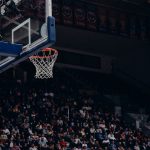Dribbling is a fundamental skill in basketball that involves the player bouncing the ball with one hand while moving around the court. It is an essential skill for players to master as it allows them to maintain possession of the ball while evading defenders and creating scoring opportunities. The key to effective dribbling lies in the ability to control the ball with precision and speed, while also being able to change direction and pace quickly.
To achieve this, players must develop a strong dribbling technique, hand-eye coordination, and agility. Dribbling involves using the fingertips to control the ball, rather than the palm of the hand. This allows for greater control and maneuverability, as well as the ability to change direction and speed quickly.
Players should keep their head up and eyes forward while dribbling to maintain awareness of the court and their teammates. Additionally, players should use their non-dribbling hand to protect the ball from defenders and maintain a low center of gravity to stay balanced and agile. Mastering the fundamentals of dribbling is crucial for players to become effective ball handlers and playmakers on the court.
Key Takeaways
- Dribbling is a fundamental skill in basketball that involves bouncing the ball with one hand while moving around the court.
- Developing hand-eye coordination is crucial for successful dribbling, as it allows players to control the ball while keeping an eye on the game.
- Mastering different dribbling techniques, such as the crossover and behind-the-back dribbles, can help players evade defenders and create scoring opportunities.
- Understanding defensive pressure and ball control is essential for maintaining possession and making effective plays on the court.
- Enhancing agility and quickness through dribbling drills and exercises can give players a competitive edge in game situations.
Developing Hand-Eye Coordination
Hand-eye coordination is a critical skill for basketball players, especially when it comes to dribbling. It involves the ability to coordinate the movements of the hands and eyes to track the ball and make precise movements with it. Developing hand-eye coordination is essential for dribbling as it allows players to control the ball with precision and react quickly to changes in the game.
Importance of Hand-Eye Coordination in Dribbling
To improve hand-eye coordination, players can engage in various drills and exercises that focus on tracking and controlling the ball with their hands. One effective way to develop hand-eye coordination for dribbling is through repetitive ball handling drills such as stationary dribbling, crossover dribbles, and behind-the-back dribbles. These drills help players become more comfortable and confident in their ability to control the ball with both hands while maintaining awareness of their surroundings.
Drills and Exercises for Improving Hand-Eye Coordination
Additionally, using visual cues such as cones or markers on the court can help players improve their ability to track the ball and make precise movements with it. By consistently practicing hand-eye coordination drills, players can enhance their dribbling skills and become more effective ball handlers on the court.
Benefits of Improved Hand-Eye Coordination
Mastering Different Dribbling Techniques

Mastering different dribbling techniques is essential for basketball players to become versatile ball handlers on the court. There are various types of dribbles that players can utilize to evade defenders, create scoring opportunities, and maintain possession of the ball. Some of the most common dribbling techniques include the crossover dribble, behind-the-back dribble, spin move, hesitation dribble, and in-and-out dribble.
Each of these techniques requires a different set of skills and movements, but mastering them can make a player more unpredictable and difficult to defend. The crossover dribble is a fundamental move that involves quickly switching the ball from one hand to the other while changing direction. It is an effective way to create space from defenders and drive towards the basket.
The behind-the-back dribble is another useful technique that involves bouncing the ball behind the player’s back to evade defenders and change direction. Mastering these techniques requires practice, patience, and a deep understanding of how to control the ball with precision and speed. By mastering different dribbling techniques, players can become more versatile and effective ball handlers on the court.
Understanding Defensive Pressure and Ball Control
| Player | Defensive Pressure | Ball Control |
|---|---|---|
| Player 1 | High | Excellent |
| Player 2 | Medium | Good |
| Player 3 | Low | Average |
Understanding defensive pressure and maintaining ball control is crucial for basketball players to become effective dribblers. Defenders will often apply pressure on the ball handler in an attempt to force turnovers or disrupt offensive plays. To counter this, players must develop strong ball-handling skills and be able to protect the ball from defenders while maintaining their composure.
This requires players to stay low, keep their body between the defender and the ball, and use their non-dribbling hand to shield the ball from reaching defenders. Maintaining ball control under defensive pressure also involves being able to change direction and speed quickly while keeping the ball secure. Players should practice maintaining their dribble under pressure by simulating game-like situations in practice drills.
By understanding defensive pressure and developing strong ball control skills, players can become more confident and composed when facing aggressive defenders on the court.
Enhancing Agility and Quickness
Agility and quickness are essential attributes for basketball players to become effective dribblers. These physical traits allow players to change direction, accelerate, and decelerate quickly while maintaining control of the ball. Developing agility and quickness involves improving footwork, reaction time, and overall athleticism.
Players can enhance their agility and quickness through various drills such as ladder drills, cone drills, and plyometric exercises. Ladder drills are particularly effective for improving footwork and agility as they require players to perform quick and precise movements through a series of ladder rungs. Cone drills can also help players improve their ability to change direction quickly while maintaining control of the ball.
Additionally, plyometric exercises such as box jumps and lateral bounds can help players improve their explosive power and overall quickness on the court. By consistently working on enhancing their agility and quickness, players can become more elusive and difficult to defend when dribbling the ball.
Utilizing Crossover and Behind-the-Back Dribbles

The Crossover Dribble: A Fundamental Move
The crossover dribble is a highly effective technique for basketball players to create space from defenders and change direction quickly while maintaining possession of the ball. This move involves quickly switching the ball from one hand to the other while changing direction, allowing players to create separation from defenders and drive towards the basket. It is a fundamental move that requires precision, speed, and timing to execute effectively.
The Behind-the-Back Dribble: A Useful Technique
The behind-the-back dribble is another useful technique that involves bouncing the ball behind the player’s back to evade defenders and change direction. This move requires players to have strong hand-eye coordination, as well as the ability to control the ball with precision while executing a quick and fluid motion behind their back.
Unpredictability on the Court
By utilizing crossover and behind-the-back dribbles effectively, players can become more unpredictable and difficult to defend on the court. These moves allow players to create space, change direction quickly, and maintain possession of the ball, making them a valuable asset to any basketball team.
Practicing Dribbling Drills and Exercises
Practicing dribbling drills and exercises is essential for basketball players to improve their ball-handling skills and become more effective dribblers on the court. There are various drills that players can engage in to enhance their dribbling abilities, such as stationary dribbling, two-ball dribbling, cone drills, and full-court dribbling drills. These drills help players develop better control, hand-eye coordination, agility, and quickness with the ball.
Stationary dribbling drills involve practicing basic dribbling movements while standing in place, focusing on controlling the ball with precision using both hands. Two-ball dribbling drills require players to simultaneously dribble two balls at once, which helps improve coordination and ambidexterity. Cone drills involve maneuvering around cones or markers on the court while maintaining control of the ball, which helps improve agility and quickness.
Full-court dribbling drills involve dribbling the ball at full speed up and down the court while maintaining control under pressure, which helps simulate game-like situations. In conclusion, mastering the fundamentals of dribbling is essential for basketball players to become effective ball handlers on the court. Developing hand-eye coordination, mastering different dribbling techniques, understanding defensive pressure, enhancing agility and quickness, utilizing crossover and behind-the-back dribbles, and practicing dribbling drills are all crucial aspects of becoming a proficient dribbler.
By consistently working on these skills through dedicated practice and repetition, players can improve their ability to control the ball with precision, evade defenders, create scoring opportunities, and contribute to their team’s success on the court.
If you’re looking to improve your basketball skills, you might want to check out this article on how to improve your shooting technique. It’s important to have a well-rounded game, and being able to shoot accurately is just as crucial as dribbling effectively. So, take the time to work on both aspects of your game to become a more well-rounded player.
FAQs
What is dribbling in basketball?
Dribbling in basketball is the act of bouncing the ball with one hand while moving around the court. It is a fundamental skill that allows players to maintain possession of the ball while maneuvering around defenders.
Why is dribbling important in basketball?
Dribbling is important in basketball as it allows players to move with the ball, evade defenders, and create scoring opportunities. It is a fundamental skill that all basketball players must master.
What are the basic techniques for dribbling a basketball?
The basic techniques for dribbling a basketball include keeping your head up, using your fingertips to control the ball, and maintaining a low and athletic stance. It is important to practice dribbling with both hands to become a well-rounded player.
How can I improve my dribbling skills?
To improve dribbling skills, players should practice dribbling drills such as stationary dribbling, crossover dribbling, and speed dribbling. It is also important to work on hand-eye coordination and ball handling exercises.
Are there any rules for dribbling in basketball?
In basketball, players are not allowed to carry or palm the ball while dribbling. Additionally, players must not double dribble, which means stopping the dribble and then starting again, or dribbling with both hands simultaneously.










